
 The newsletter of NASA's Radio JOVE Project
The newsletter of NASA's Radio JOVE Project "Planetary Radio Astronomy for Schools"

 The newsletter of NASA's Radio JOVE Project
The newsletter of NASA's Radio JOVE Project These past few months many Radio Jove participants and others in the planetary radio astronomy community participated in events to recognize the 50th anniversary of the discovery of the first detection of radio emissions from another planet. On April 6, 1955 Drs. Burke and Franklin announced their discovery that Jupiter was a powerful source of radio waves. See the Radio Jove Science Brief, "The Discovery of Jupiter's Radio Emissions" at http://radiojove.gsfc.nasa.gov/library/sci_briefs/discovery.html for more details.
Among the events that marked the anniversary are the following:
In January of this year Jim Thieman presented a poster at the San Diego meeting of the American Astronomical Society that gave details on our visit to the discovery site, our archival research at the Carnegie Institution of Washington and the work towards having official recognition of the historic importance of this site by the state of Maryland (A copy of the poster is available at http://radiojove.gsfc.nasa.gov/library/pubs/M_B_post.jpg).
This poster drew the attention of writers of the nationally syndicated "StarDate" radio program. Two episodes were produced to coincide with the anniversary date. The first on April 5th gave details on Jupiter as a source of radio waves. The second episode on April 6th presented the story of the discovery. Text and sound files of the two episodes are archived at the StarDate web site, ( http://stardate.org/radio/calendars/s200504cal.html ) and in Spanish at the Universo web site ( http://radiouniverso.org/radio/calendars/u200504cal.html ).
On April 5th, Drs. Burke and Franklin joined in an advertised anniversary teleconference. Over 50 people including many Radio Jove participants from the U.S., Europe and Japan, students and scientists spent over an hour asking questions and hearing the unique perspectives of these two men. The entire teleconference was recorded, portions will be made available through the Radio Jove website and will be preserved along with several other recordings at the archives of the Carnegie Institution of Washington.
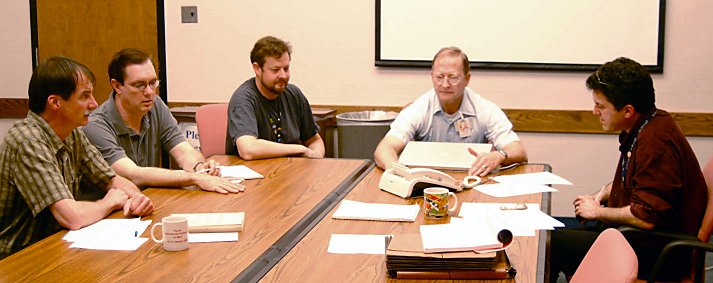
On April 6th the state of Maryland installed a roadside historic marker near the former site of the Seneca Observatory's Mills Cross Array. This instrument was the one used by Burke and Franklin for their discovery though nothing remains of the instrument today. See the December 2004 Jove Bulletin article on our visit to the Seneca Observatory site, "50 Years of Jupiter Radio Observations: Travels through Space and Time" (http://radiojove.gsfc.nasa.gov/library/newsletters/2004Dec/#2).
In his application for the historic marker Leonard Garcia noted that,
"The state of Maryland continues to be a site of important research in planetary radio astronomy. [Maryland's] NASA/GSFC has one of the largest research programs in the world dedicated to the study of the energetic particle and field (typically referred to as "plasma") environments of Earth, the planets and the Sun. NASA/GSFC is also host to the Radio Jove education and public outreach project (http://radiojove.gsfc.nasa.gov). Through this project, students learn about radio astronomy by making their own observations of radio emissions from Jupiter and the Sun using radio receivers and antennas they build themselves from kits. Radio Jove has sold over 600 kits to students and radio amateurs in nearly every state and 30 countries."
The text of the marker reads,
planetary radio emissions
discovery sitein 1955, scientists bernard burke and kenneth franklin from the carnegie institution of washington accidentally discovered naturally-generated radio waves from jupiter using a 96-acre antenna array. this discovery led to greater understanding of planetary magnetic fields and plasmas and opened a new window in our exploration of the solar system.

On April 20-22, several Radio Jove participants traveled to the 6th International Conference on Planetary and Solar radio emissions in Graz, Austria, also known as PRE VI. Hannes Mayer has a summary of the meeting in this issue of the Jove Bulletin. The PRE VI website, the program booklet and the first two talks of the conference gave special recognition to the 50th anniversary of planetary radio emissions. Leonard Garcia presented the first talk of the conference on behalf of Ken Franklin who unfortunately was unable to attend. Bernard Burke gave the next talk on 50 years of Jupiter radio science and his thoughts on the future.
We are currently working with the Department of Terrestrial Magnetism of the Carnegie Institution of Washington (DTM/CIW) in having an unveiling ceremony of the roadside marker, a series of talks and a reception for Drs. Burke and Franklin at the DTM campus in Washington, D.C. This event is scheduled for September 29, 2005.
The Planetary Radio Emissions (PRE) workshops are a series of international meetings held in Graz, Austria. Established in 1984, the workshops soon became an important platform for scientists from all around the world to discuss the latest findings and research results in the field of non-thermal radio emissions from the five radio planets Earth, Jupiter, Saturn, Uranus, and Neptune, and from the Sun, the heliosphere, and extra solar planets. This year a special emphasis was placed on the recent measurements of the Cassini spacecraft now in orbit around Saturn.
One of the highlights of the workshop was the celebration of the 50th anniversary of the discovery of Jovian radio emissions by Bernard Burke and Kenneth Franklin. Dr. Burke was invited for a talk about the discovery - needless to say that everyone was keen to get a photo with him. Dr. Franklin unfortunately was hindered, but Leonard Garcia presented the talk about the Mills Cross [2] on behalf of Dr. Franklin.
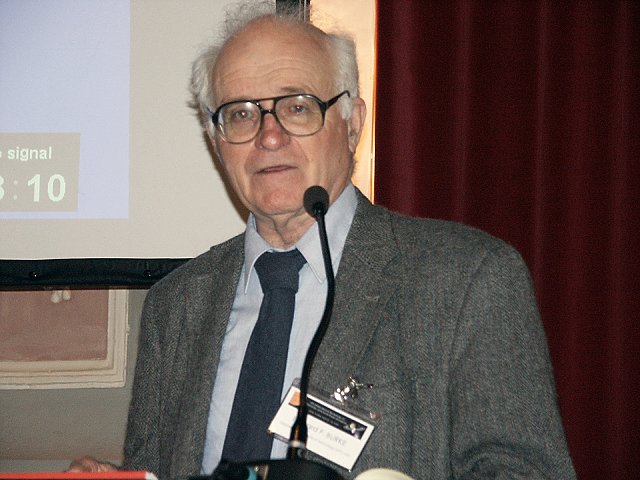
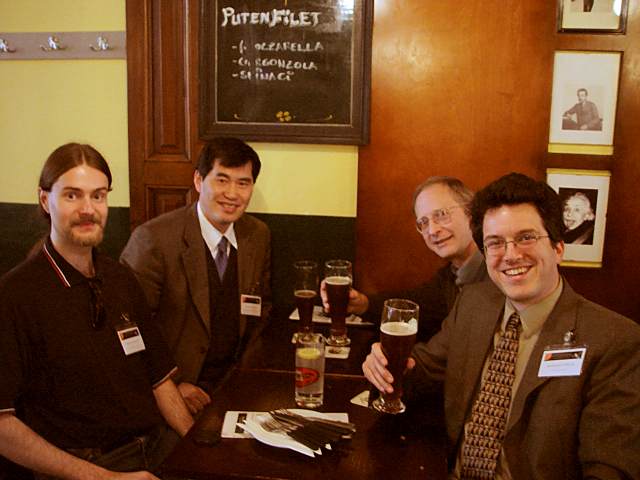
The RadioJove project was present with a poster by Jim Thieman and additionally with a RadioJove receiver including Richard Flagg's noise generator for calibration. The poster included information about the project itself, the professional observatories in Florida and Hawaii, the data acquisition via SkyPipe and the new UFRO [3] spectrograph.
As mentioned earlier, special emphasis was placed on the Cassini mission [4]. Scientists presented results and new findings in talks covering topics like the radio and plasma wave observations [5], Saturn Kilometric Radiation (SKR), Saturn's magnetic field [6], radio lightning and much more.
Of course Jupiter was a big topic as well. Our fellow Jovian Kazumasa Imai gave a talk on his new findings about the Io-A/B source region, which was illustrated by excellent computer graphics and animations [7]. The Low Frequency Array (LOFAR) project [8] will be in operation soon and folks are looking forward with eagerness to the first Jupiter observations.
Several scientists also gave talks about solar radio emissions measured by either ground based observatories or spacecraft.
Our fellow Jovian Leonard Garcia presented results of recent satellite-based observations of Earth's Auroral Kilometric Radiation (AKR). To round off the picture, proposals and outlooks for detecting decametric emission from extra solar planets were presented. For a complete list of abstracts, visit the PRE6 abstracts page [9].
Summa summarum, I was pretty impressed by the diversity of research going on in this exciting field of science with ground-based observations and also measurements made by interplanetary spacecraft. I highly recommend attending the workshop - the wealth of information presented during the workshop has strengthened my interest in Jupiter radio emissions, raised plenty of questions I need answers for and also triggered personal interest for new domains such as Saturn Kilometric Radiation (SKR), Auroral Kilometric Radiation (AKR) and solar emissions. The proposed experiments and those in development promise exciting times ahead of us - stay "tuned"!
The Society of Amateur Radio Astronomers (SARA) was founded in 1981, with the purpose of educating those interested in pursuing amateur radio astronomy. The Society is open to all those wishing to participate. SARA members have many interests, some are as follows: Solar Radio Astronomy, Galactic Radio Astronomy, Meteor Detection, Jupiter, Gamma Ray/High Energy Pulse Detection, Antennas and Design of Hardware and Software.
The members of the Society offer a friendly mentor atmosphere. All questions and inquiries are answered in a constructive manner. No question is silly!
SARA offers its members a bi-monthly journal entitled "Radio Astronomy". Within the journal, members report on their research and observations. In addition, members receive updates on the professional radio astronomy community and, Society news.
Once a year, SARA meets for a three-day conference at the National Radio Astronomy Observatory, located in Green Bank, West Virginia, USA. In addition, SARA members host regional meetings in other parts of North America and abroad, catering to those who cannot attend the yearly conference. Also, members offer their speaking services to groups and organizations wanting to learn about radio astronomy and SARA.
Dues are: Adults $24.00 (U.S.), $30.00 (Canada and Mexico), and $36.00 (other foreign countries). Students (someone attending school full-time) $10. Included with your membership is a subscription to "Radio Astronomy", The Journal of the Society of Amateur Radio Astronomers. Members who choose to receive an electronic email Journal, pay dues of $20.00 U.S. For further information, see our website at: http://www.qsl.net/SARA/. (Non - US members: Please make sure your payment are in US dollars and written on a US bank). Make all checks and money orders payable to SARA. The contact address is: Tom Crowley, 3912 Whittington Drive, Atlanta, GA 30342, (404)233-6886, tomcrowley@mindspring.com.
Dr. Carmen Pantoja of the University of Puerto Rico is working with members of Soka Gakkai International (SGI) and Soka University on a radio astronomy education project. This program entitled the "Shirohisa Ikeda Project" is named after the son of Daisaku Ikeda, president of the SGI and Soka University. Mr. Shirohisa Ikeda was a young man who passed away recently and this new project named in his honor will reach out to young people especially those who are blind.
In a letter about the project Dr. Antonio Martinez Collazo, head of the Physics Department at the University of Puerto Rico and Dr. Pantoja assistant professor wrote, "The project will introduce the attractiveness of astronomy to students who study physics especially the visually impaired. This is possible thanks to the NASA Radio JOVE project. A project that makes possible hearing the sounds of Solar and Jovian Activity." Through a donation from SGI the physics department at the University of Puerto Rico has been able to obtain new receivers and calibrators to improve their radio telescope. They have also acquired a collection of reference books in astronomy for their lab. An article on their project and collaboration appeared in the May 17 issue of the Japanese newspaper, Seikyo Shimbum.
Leonard Garcia and Jim Thieman, presented a prototype of the Solar System Radio Explorer Kiosk (SSREK) as part of a NASA exhibit at the 82nd convention of the Council for Exceptional Children (CEC) on April 7-9, 2005 in Baltimore. (CEC) is the largest international professional organization dedicated to improving educational outcomes for individuals with exceptionalities, students with disabilities, and/or the gifted. More than 1000 teachers, including pre-service and administrators, visited the NASA Science Mission Directorate exhibit and received resources from the various space science missions, forums, and brokers. Leonard and Jim demonstrated the kiosk to meeting participants and gathered feedback to help in further refining the kiosk. Among the visitors to the kiosk was Mark Riccobono of the National Federation of the Blind.
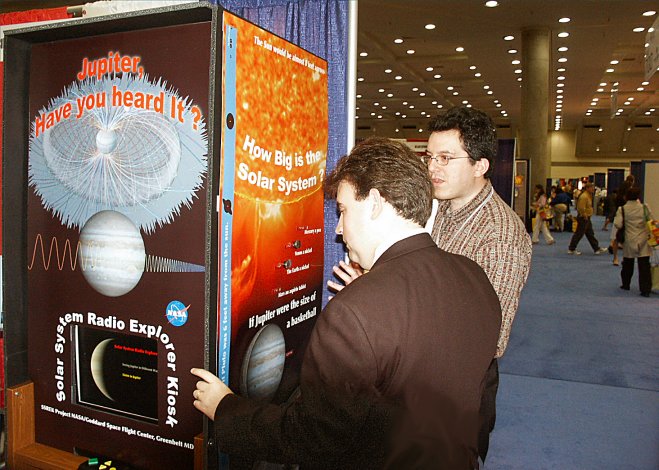
This summer we hope to receive more evaluations on the kiosk from students and interns at GSFC as well as representatives from the Maryland Science Center. Bill Pine will also be visiting GSFC to assist us in developing a more refined version of the SSREK. For more details on the SSREK project see our website at http://radiojove.gsfc.nasa.gov/ssrek/
Have you ever wondered what happens to all the data you submit to the JOVE archive? It's not only stored for educational purposes, but for research purposes as well. The objects we observe, both Jupiter and the Sun, produce burst events in a cyclical manner, for example, the 11 year sunspot cycle and the particular alignment of Io and Jupiter to produce the Jovian L and S bursts. In these cases, data has to be collected whenever possible for later study and analysis. Sometimes this analysis can take place years after the data was originally taken and archived. It's only when a large sample of data points are collected and studied when patterns emerge. In the case of the discovery of the Jovian bursts, a 5-year baseline of data was assembled to allow Burke and Franklin (http://radiojove.gsfc.nasa.gov/library/sci_briefs/discovery.html) to establish some prediction guidelines.
Data must be capable of producing the same or similar results and conclusions to those reported by JOVE observers if used by an independent and competent person. The data presented and the conclusions drawn must be capable of being checked against the data from whence they were developed.
To this end, calibration of our equipment becomes increasingly more important for the valuable data we collect to be of significant value. The data becomes even more useful if the calibration is entered into SkyPipe and the display showing the burst in degrees Kelvin without the need to extrapolate. With the ability to add calculations to the newest version of SkyPipe, the display value from the receiver can now be shown in degrees Kelvin. Equations were introduced in version 1.2.11 so older versions of SkyPipe will not have this feature.
The RF2020 (manufactured by Richard Flagg - rf@hawaii.rr.com) calibrated noise source generator is applied to the input of JOVE receiver (This procedure will also work with any receiver being used). A calibration run is made for the receiver.The results are loaded into SkyPipe and each temperature level is averaged using a feature in SkyPipe, "Get Avg for View". An equation needs to be found that relates the temperatures from the calibrator settings to the corresponding amplitude averages. Details on this procedure and how to then enter this formula into SkyPipe are given on the following web sites.
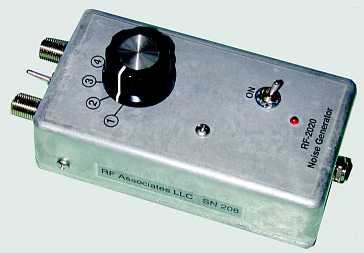
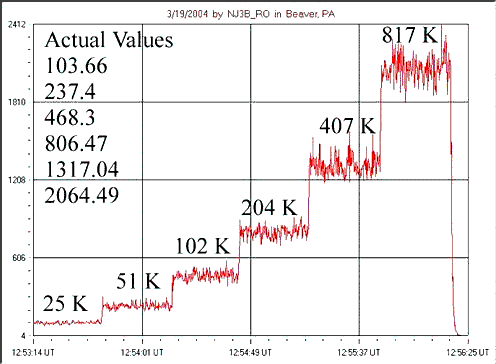
With these calculations in place, SkyPipe now displays the output in degrees Kelvin. Any researchers need only look at the charts picture to get the correct value of the intensity of each burst studied. If you should make ANY adjustments to the audio output of your receiver, or adjust the sound settings, you will need to recalibrate, generate a new formula and enter that into SkyPipe. If you're using an A/D converter, your chances are reduced because the only thing adjustable at this point is the volume control on the receiver. Just put a Post-A-Note on the receiver, 'Do Not Touch'.
I haven't spoken to a large audience since my college public speaking course many years ago. But on the last day of December 2004 I got a request from Lynn Laux, the president of the Cuyahoga Astronomical Association(CAA) and also a member of my own club, to schedule an appearance as a guest speaker for one of their club meetings. I immediately said yes and contacted Les Fox, the vice president, to schedule a date. I was very happy to have the opportunity to share Radio Jove with anyone because I am the only one of my kind that I know of here in north-east Ohio. There are a few other "Jovians" here in Ohio but it's a big state and we are scattered over a large area.
Les contacted me to schedule a presentation on June 13th and as I was preparing for this, my first public speaking engagement, I got another contact from Ohio asking me to guest speak. Tammy Plotner of the Richland Astronomical Society(RAS) and the Warren Rupp Observatory, who is also a member of the Radio Jove list community, has extended an invitation to be a guest speaker at the Hidden Hollow Star Party, near Mansfield, Ohio. After communicating about many things through email it has been decided that I will also demonstrate the Jove telescope. Unfortunately there will be no Jupiter and I can only hope we have some good solar activity.
As you well know by reading this article June 13th has passed and so then also has my first speaking engagement at the CAA. It was an overall success and I did have one serious enquiry from a gentleman who is with a local planetarium. I gave him my contact information and await his reply. As nervous as I was through the whole thing I was asked by Les, the vice president, if I was sure that I hadn't done this before. Thanks for the confidence booster Les! Lynn Laux later told me that she had absolutely no idea what to expect from my presentation but that after hearing it she now understood a bit more about what all those charts and graphs were I keep sending out on the club email list.
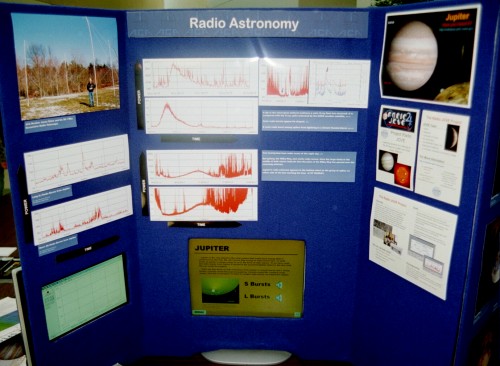
On May 7, 2005 the Astronomy Club of Akron(ACA), of which I am a member, held a public outreach program in a local library facility as an extension of activities associated with world wide Astronomy Day. I volunteered for the project and came up with the idea of building displays featuring astrophotography by our club members. Since I was also involved in radio astronomy it occurred to me that a kiosk of sorts featuring radio sounds from Jupiter and the Sun might add something unique.
The astrophotography displays consisted of project board, the kind normally used in school science projects or displays, covered in blue felt. The photos were digitally processed and printed using a computer and photo printer on photo quality paper. Cardboard rectangles slightly less than the size of the photos were cut from boxes and pasted onto the back to prevent the photos from curling. Two squares of only the hook side of a Velcro strip were then put on the backs of each photo so that it could stick to the blue felt covering the display board. The radio astronomy kiosk was made in this fashion with the exception that two square openings were cut into the lower part of the board. They were cut just big enough to allow a complete view of a computer monitor placed directly behind. Two computers were used to display the user menu and to display Skypipe software. The user interface is simply the mouse. I kept the design of the kiosk program as light as possible. The theory behind it being that the less anyone has to click the less likely they are to get bored with it. To hear the sounds one simply selects the object desired from the menu and a second frame appears with sound clips. Clicking the sound clip buttons will play the sound and at the same time the second computer charts what is heard.
Was it a success? Well it happened that May 7th was hardly a day for anyone to be in a library. Ohio doesn't get many days with sunny skies and warm weather. We had a few members of the public come by our displays, but I think most of the interest in the radio astronomy display came from some of our club members. It's just too soon to tell what kind of venue works best. But I suspect every museum needs a big red button for kids to press and drive their parents crazy listening to that wonderful popping sound from Jupiter.
The Windward Community College Radio Observatory (WCCRO) continues to operate 24/7 streaming SkyPipe, spectrograph data, audio, and Java enabled stripcharts. Power line interference (seen as diagonal bands) on the radio spectrograms continues to be a problem. As the source of this interference is located in a residential subdivision to the west of our antenna, we have been leaving the log-periodic antenna aimed toward the SE at an elevation angle of about 35 degrees. This orientation minimizes interference and is suitable for observations of either Jupiter or the Sun for a few hours after they rise, here in Hawaii.
Currently our radio equipment is installed in a small concrete block building that was formerly used for storing various chemicals and strange things in glass jars used in the biology program.
A new observatory is currently under construction and we plan to move the radio equipment and computers into this new building within the next few months. The observatory will house optical telescopes in addition to the radio equipment, and will include classroom space. This will provide us the opportunity to demonstrate the Jove equipment to more students in the WCC astronomy classes.
WCCRO will continue as a testbed for improving the Jove spectrographs (located here in Hawaii and in Florida at UFRO). New software will be tested in the next few months to enable archiving of scheduled observations such as Io-related Jupiter emissions.
The observations for the 2004-2005 Jupiter season at UFRO began on December 18, 2004 and continued until June 9, 2005. A total of about 126 nights of observation were completed during the observing season. There were gaps of several days with no observations due to periods of lightning storms. An earlier observation during Jupiter's lunar occultation was also made on December 7, 2004.
The observations were made at the approximate frequencies of 18, 20, 22, 24, 26, 28, and 32 MHz using the TP antenna array. Both the right and left circular polarization were recorded at the sampling rate of 2 samples/sec. A standard Radio JOVE two-dipole array and receiver was also operated. The signals from the 18, 20, and 22 MHz channels, both right and left hand polarizations plus the 20 MHz RJ channel were made available live at the Internet Jupiter Radio Observatory (IJRO) website in Japan. The virtual chart recorder is accessible on the Internet using a web browser at the IJRO website http://jupiter.kochi-ct.jp. Archived data for most of the nights of observations done at UFRO can be found at this website.
A spectrograph covering the frequency range from 18-28 MHz was operated during the season. This spectrograph is accessible on the network using special software that can be downloaded for free at the following website http://jupiter.wcc.hawaii.edu/spectrograph_software.htm. With this software it is possible to connect to the spectrograph and display the live spectra from the low frequency emission of the sun during the day, and from Jupiter at night when the sun or planet are in the beam of the TP array.
Audio streaming from the low frequency INSPIRE" receiver, the 20 MHz Radio
JOVE receiver, and the 20 MHz TP antenna channels was also available
during the observing season.
[" Editor's note: see http://image.gsfc.nasa.gov/poetry/inspire/ for information about the INSPIRE project.]
On June 10, the UFRO equipment was shutdown for the season to protect it from the frequent Summer lightning storms. The equipment will be reconnected around October so that data and audio streaming can be resumed. First the audio streaming from the INSPIRE and data and audio from solar observations will start. Jupiter observations will resume around the beginning of January.
This software may be downloaded from the Radio JOVE software page http://radiojove.gsfc.nasa.gov/dal/software.htm .
Note: Some newer computers have shown timing problems when using Radio-SkyPipe software. This problem has been fixed in the latest version of Radio-SkyPipe. You can always find the latest version of Radio-SkyPipe by going to:
http://radiosky.com/skypipeishere.html
The JOVE Bulletin is published twice a year. It is a free service of the Radio JOVE Project. We hope you will find it of value.
Back issues are available on the Radio JOVE Project Web site, http://radiojove.gsfc.nasa.gov/
For assistance or information send inquiries to: